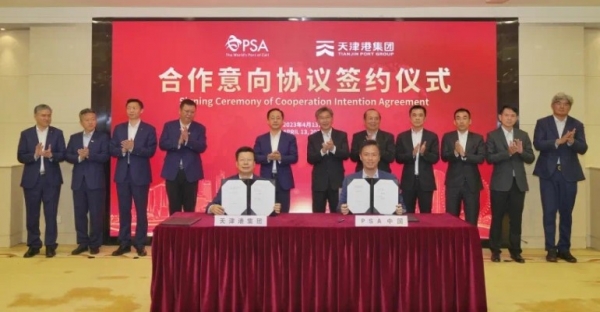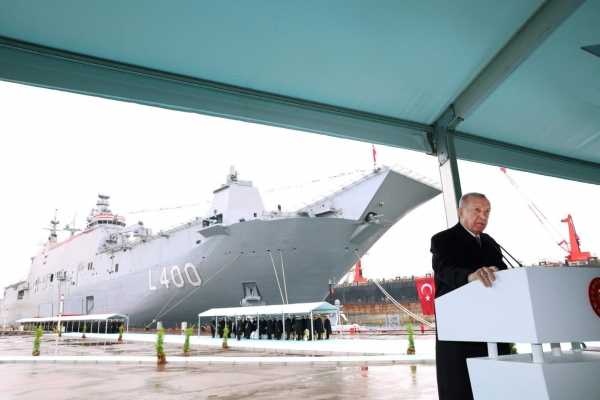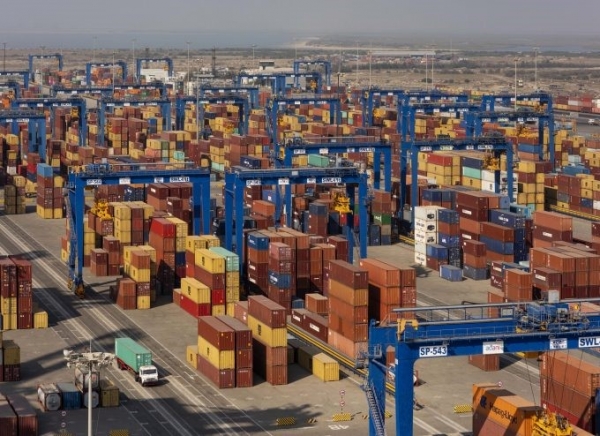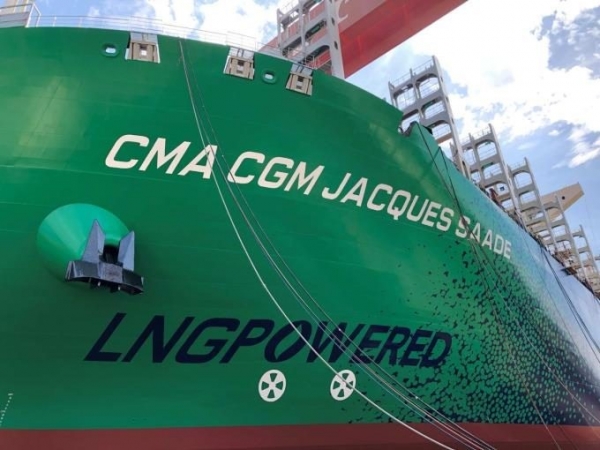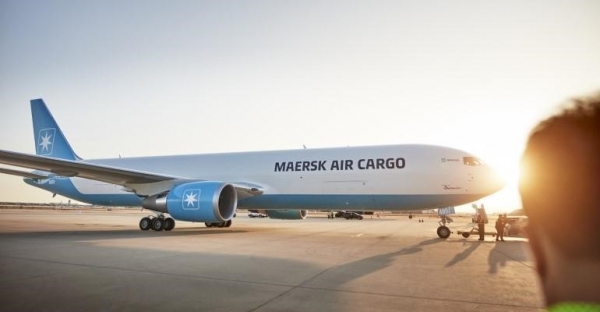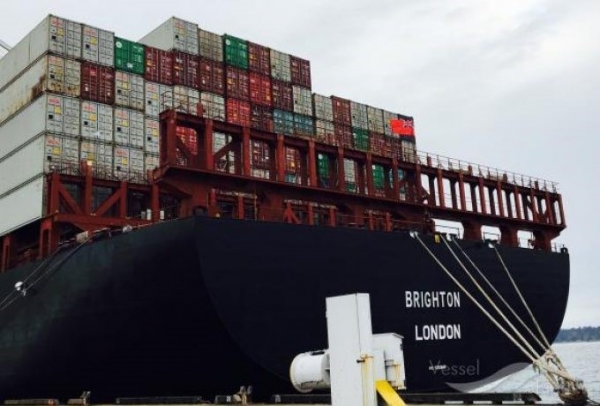News
Latest news
Russia, Kazakhstan, Turkmenistan Team Up to Boost Transportation
The railway companies of Russia, Kazakhstan, and Turkmenistan have signed a memorandum to establish a joint venture that will concentrate on transportation development.
On Friday, Kazakhstan's KTZ Express released a statement announcing that KTZ Express JSC, JSC RZD Logistics, and Transport and Logistics Center of Turkmenistan JSC had signed the document during the 27th International Exhibition of Transport and Logistics.
“The parties agreed to combine their competencies to form competitive tariff rates and “seamless” transportation of goods from Kazakhstan, Russia, Turkmenistan to Iran, India, the countries of the Middle East and the Asia-Pacific region with the participation of Aksaraiskaya, Ozinki, Bolashak, Inche-Burun, Serakhs border crossings and in the opposite direction,” the press release reads.
According to the press service, the joint venture will operate rail freight services on the eastern branch of the International North-South Transport Corridor (INSTC).
The INSTC is a multimodal network spanning 7,200 kilometers of ship, rail, and road routes. It is designed to provide the shortest multi-modal transportation route linking the Indian Ocean and the Persian Gulf to the Caspian and Baltic Seas.
Compared to the sea route via the Suez Canal, the INSTC reduces the distance by more than half, resulting in lower transportation costs and shorter transit times. In addition, the INSTC provides an alternative connectivity initiative to countries in the Eurasian region and reduces the time and cost for the transfer of goods from India to Russia and Europe via Iran.
The INSTC currently unites multiple transport systems across various countries, with Russia and Iran being the two countries contributing the most to the infrastructure development projects, accounting for 34.6 percent and 33.7 percent of total planned investments, respectively. Kazakhstan has a 16.5 percent share of investment in the INSTC's development.
Recent statistics indicate that over 0.6 million tons of cargo were transported from the stations of the northern railways along the North-South International Transport Corridor (ITC) in 2022. The volume of shipments in this direction increased by 36.3 percent compared to the previous year, with 448,000 tons of cargo shipped along the western branch of the ITC through Azerbaijan, and 130,000 tons of cargo shipped along the eastern branch through Kazakhstan and Turkmenistan. During the same period, the ports of the Caspian Sea shipped 26.6 thousand tons of cargo, marking an increase of more than 14 times.
It is projected that by 2030, the volume of Russian cargo transported through the North-South ITC will double from 17 million tones to 32 million tones. This growth is being driven by significant geopolitical changes that are disrupting global supply chains and transport networks. As a result of these developments, the role of the International North-South Transport Corridor is becoming increasingly important.
Tianjin port and PSA enhance collaboration
Chinese port operator Tianjin Port Group and Singapore-based PSA International have inked a co-operation intention agreement to jointly develop port and new energy businesses.
The signing of the co-operation intention agreement will strengthen our strategic partner relationship and jointly promote Tianjin ports’ development to be a world-class port, and improve PSA’s business function at Tianjin and other ports along Belt and Road initiatives, said Tianjin Port.
The two sides have agreed to deepen the co-operation on the new energy sector including wind power generation and photovoltaic power, as well as more sustainable development solutions for ports.
In addition, Tianjin port and PSA will strengthen collaborations on smart port equipment manufacturing and port machinery supply to jointly improve the manufacturing and digital position of the ports.
To carry out logistics park and project construction at Tianjin port, PSA and Tianjin port will explore more joint venture opportunities on logistics, warehouse, supply chain and multi-modal transportation.
Tianjin port and PSA's co-operation has brought about several achievements on container terminal operation and talent communications since their joint venture partnership started in 2005.
Iran Seeks Joint Manufacturing Opportunities With India
Iran’s Deputy Foreign Minister for Economic Relation Mehdi Safari proposed joint manufacturing activities with India across industries.
Hoping for an enhanced bilateral trade with India this year, he told PTI that there are a lot of opportunities for the two countries.
“There are a lot of opportunities… (that) they have in the products and industries, are complementary to each other. Especially in high technology, India is very good and we are very good in (the area of) bio, nano, and kinetic (technology),” said Safari who was speaking on the sidelines of an event jointly hosted by AIAI and WTC Mumbai.
According to him, this is a joint and common area in which both countries can have common manufacturing in India or Iran and promote exports to other countries.
Turkey Launches First Amphibious Assault Ship
ANKARA, April 10 (Reuters) – Turkey launched its first amphibious assault ship on Monday, aiming to extend its drone capabilities from land-based to naval operations amid increased regional tensions as war rages in Ukraine on the other side of the Black Sea.
The TCG Anadolu can handle only light aircraft, chiefly helicopters and jets that can take off from shorter runways. It is 232 meters long and 32 meters wide, and can carry some 1,400 personnel – one battalion of soldiers – combat vehicles and support units to operate overseas.
“This vessel will allow us to conduct military and humanitarian operations in every corner of the world, when needed,” President Tayyip Erdogan said at the launch ceremony in Istanbul.
“We see this vessel as a symbol that will consolidate Turkey’s regional leadership position,” he said.
The amphibious assault ship was built in Istanbul’s Sedef Shipyard by a Turkish-Spanish consortium, based on the design of Spanish light aircraft carrier Juan Carlos I.
Ankara’s original plan was to deploy F-35 B-model fighter jets, which can take off from shorter runways, on its largest warship.
But its plans had to change after the United States removed Turkey, a NATO ally, from its F-35 program over Ankara’s purchase of Russian S-400 defense systems in 2019. Turkey then converted TCG Anadolu into a drone carrier.
In addition to helicopters, Turkey plans to deploy on the new carrier Bayraktar TB3 and Kizilelma unmanned aerial combat vehicles – both under production by Turkish defense firm Baykar – as well as Hurjet light attack aircraft being developed by Turkish Aerospace Industries (TAI).
TCG Anadolu will be the world’s first amphibious assault ship whose fleet is made up mostly of armed drones once the plan is implemented.
Turkey, which has NATO’s second largest army, shares a border with conflict-ridden Syria and Iraq and has a long Mediterranean as well as Black Sea coastline.
In the nearly 14-month Ukraine war, Turkey has positioned itself as an intermediary between Kyiv and Moscow, helping to broker with the United Nations a deal allowing for the safe export of grain from Ukrainian ports via the Black Sea.
Indian imports slowed by tech glitch in new customs clearance platform
Indian importers and supply chain players are facing difficulties securing customs clearance, due to major glitches on the national electronic data interchange platform, known as Icegate.
As a result, import containers are piling up at port locations across the country, according to industry sources.
Stakeholders are concerned over the inability to make customs duty payments through the electronic gateway, an issue Loadstar sources noted first cropped up when the authorities rolled-out the new system on 1 April.
Many industry groups, including the Brihanmumbai Customs Brokers Association (BCBA) of clearing agents in Mumbai, have raised alarm bells, calling on government policymakers for intervention and a swift resolution.
The Central Board of Indirect Taxes and Customs (CBIC) said it was making every effort to put things in order. It explained: “Our technical teams are working overtime to fix some teething issues and the problems being temporarily noticed will be resolved at the earliest.”
One Mumbai-based ocean freight forwarder told The Loadstar clearing agents were not coming forward to pick up delivery orders for vessels that arrived even last week. Containers overstaying on docks typically run the risk of demurrage fees and other penalties, with disputes often ending up in protracted legal action.
Air freight inbound shipments are also facing similar customs hiccups, a source said.
India’s freight industry has seen a raft of technological change and ease-of-doing-business reforms in recent years as the nation bids to keep pace with evolving global supply chain dynamics.
New Delhi recently laid out a broader digital platform – dubbed the national logistics portal (NLP) – offering a “one-stop shop logistics experience” for users, with visibility and transparency being the key focus.
The government said the platform “aimed at connecting all the stakeholders of the logistics community using IT to improve efficiency and transparency by reducing costs and time delays and achieving easier, faster, and more competitive offerings of services, to promote the growth of the logistics sector and thereby improve trade”.
In addition, efforts are in the works for a new electronic customs programme to tighten export/import cargo manifestations, named the Sea Cargo Manifest and Transhipment [SCMT] Regulations. In broad terms, it is akin to the 24-hour advanced manifest rule for US cargo.
But the current import clearance snags coincide with Indian export flows facing bottlenecks as a consequence of significant berth capacity cutbacks at Nhava Sheva port (JNPT), with perishables movements bearing the brunt of the congestion.
LNG impact on decarbonising shipping 'negligible', claims green group
A UMAS report dismissing LNG as “a statistical irrelevance” in the rush to decarbonise shipping, has coincided with a new campaign against its adoption.
However, shipping’s adoption of LNG shows no signs of slowing down, with some 50 new port bunkering facilities planned by 2025, as well as making up 81% of alternative-fuel vessel orders last year.
But campaign group Say No To LNG aims to rule out the fossil fuel as part of any decarbonisation scenario, pointing out that methane emissions – the main component of LNG and some 80 times as potent a greenhouse gas as CO2 – have increased by 150% in six years as ships and other industries switch to the fuel.
According to UMAS data, despite the enormous research and development cost of developing new engine types, fuel feeds and tank systems, and even new ship designs for burning LNG, its effect on decarbonisation will have been “a statistical irrelevance”.
It said: “LNG provides a negligible impact on well-to-wake greenhouse gas emissions… and so there is no material change in the overall WtW GHG reduction, regardless of the take-up of LNG between now and 2030.”
UMAS condemned the “complacency” across the shipping sector, which, it claims, has prioritising adoption of new zero-carbon fuels to the exclusion of improving fuel efficiency.
“Industry is increasingly under pressure to align with 1.5ºC and has broadly embraced that this can only be achieved by a fuel transition,” said Jean-Marc Bonello, principal consultant at UMAS. “However, this may distract from the fact that significant gains in energy efficiency through technologies, including wind assist, and operational measures are needed this decade so start reducing GHG now.”
Though not applicable on all trades, existing sail designs have been responsible for reducing fuel consumption by around 30% in some cases, and some designers, such as Wilhelmsen, anticipate being able to operate with wind providing 90% of their propulsion.
Other efficiency upgrades include air lubrication, hull optimisation, and aft-hull additions such as fins and ducts.
UMAS director Tristan Smith said shipping was “on track for a complacent 2020s, followed by a highly disruptive 2030s, caused by a turbulent, expensive and late fuel transition.”
Instead, he added, an accelerated timeline of investment was needed not only to change fuels, but also to whittle down the fuel use of the average vessel.
However, industry lobby group Sea-LNG, which recently expanded to include another fossil fuel company, Énestas, to its board’s line-up, has criticised what it has called “sensationalist claims” on methane slip, characterising them as “a transparent attempt to distract the industry from investing in LNG”.
Its COO, Steve Esau, called methane slip “effectively solved” in two-stroke diesels, “which make up more than half of the LNG-fuelled vessels on order today”.
At COP 26 in Glasgow at the end of 2021, more than 100 countries signed a declaration to cut LNG use, including the US, UK and the EU. EC president Ursula von der Leyen told COP LNG was “the lowest hanging fruit” – ie, the easiest method to cut greenhouse gas emissions.
Maersk launches new US-China air freight services
A.P. Moller - Maersk has launched two new air cargo services between the US and China.
The services will launch with two weekly flights between Greenville-Spartanburg International Airport (GSP) and Shenyang Taoxian International Airport (SHE), and with two weekly flights between Chicago Rockford International Airport (RFD) and Hangzhou Xiaoshan International Airport (HGH). From May 2023, both services will be boosted to three weekly flights.
Maersk Air Cargo’s three new Boeing 767-300 freighters will serve the links and will be operated by Miami-headquartered cargo airline, Amerijet International.
Maersk said the new services aim to meet the end-to-end logistics needs of its customers and plug a connectivity gap between the US and China. Connecting the two largest markets for its ocean customers, the air services will add options for high value and time sensitive cargos, it said.
“With the introduction of these new routes, we are further connecting North America and Asia Pacific through regular flights and controlled capacity for our customers. At Maersk, we want to ensure that our customers have the visibility, reliability, and resilience in their supply chains. Air freight continues to be an important asset in our customer´s end-to-end logistics needs,” says Michel Pozas Lucic, Global Head of Air in A.P. Moller – Maersk.
Maersk launched an air service connecting Denmark to China in March 2023, with three weekly flights between Billund, Denmark (BLL) and Hangzhou, China (HGH). Another Asia-US link was also added, connecting Greenville-Spartanburg, South Carolina (GSP) and Incheon, Korea (ICN).
Hapag-Lloyd launching new Latin America service
Hapag-Lloyd is launching a new service connecting ports in Peru and Chile.
The WCSA Feeder 4 (WS4) service is set to commence in June and vessels will calle the following port rotation: Callao (Peru) – Iquique (Chile) – Puerto Angamos (Chile) – Arica (Chile) – Callao (Peru).
Hapag-Lloyd said the first boxship deployed on the new rotation will be the 2023-built Cape Bruno, which is expected to arrive at Callao port on 5 June.
The German Ocean carrier said the new service will provide stronger schedule reliability, and extended port coverage, while the service is expected to replace transshipments from San Antonio in Chile to Callao.
Positive ocean freight sentiment keeps the charter market bullish.
More optimistic demand forecasts and the prospect of a better peak season this year are driving a containership charter market rally, with aggressive carriers still snapping-up tonnage as it becomes open.
According to a recent survey of supply chain professionals by logistics platform Container xChange, 48% of respondents believe this year’s peak season will be better than last year’s.
Container xChange co-founder and CEO Christian Roeloffs said industry sentiment was “gradually turning positive” and added: “We anticipate a subdued rebound in demand as retailers begin to deplete their excess stock in the coming months, leading up to the peak season.”
And carriers are hearing positive news from their major shippers that purchase orders, to replenish old stock and buy in new season lines, are starting to trickle through.
“I think we are over the worst,” a UK-based carrier contact told The Loadstar this week.
Awash with cash and eager to capture market share, the container lines have gone back to the charter market to boost their capacity and Alphaliner said this week activity in the market “remained high”, with “demand strong across the board”.
Indeed, daily hire rates are on the increase in all containership sizes, with owners demanding a minimum 12-month charter period as well as positioning compensation.
For example, Japanese ocean carrier ONE has just agreed a two-year charter for the 2008-built 6,350 teu Brighton at a rate of $32,500 a day, from 17 May. This is only slightly below the $35,000 previous charterer Wan Hai was paying for a two-year fixture during the demand boom.
The market seems to be dominated by enquiries from MSC and CMA CGM, which are continuing where they left off when the downturn hit, hoovering-up any open tonnage on the charter market, and prepared to wave their chequebooks at owners that might be interested in selling ships.
Alphaliner noted that MSC had “snapped-up another six vessels in the past days”, including two 1999-built 5,300 teu ships from rival carrier Evergreen that were expected to be sold for demolition.
The recent acquisitions takes MSC’s colossal buying spree of second-hand container tonnage to more than 300 ships since August 2020, resulting in an operating fleet capacity of 4.8m teu, close to 1m teu more than its 2M partner, Maersk.
Moreover, the Geneva-based carrier has a huge orderbook of 1.7m teu, compared with the 370,000 teu ordered by Maersk.
CMA CGM is the second-most active carrier in the S&P market, having bought 100 second-hand ships since 2020, taking its operating fleet capacity to 3.4m teu, which, with its orderbook of nearly 1m teu, will see the French carrier threaten Maersk’s second place in the global carrier rankings.
Los Angeles, Long Beach Ports Back In Operation
The ports of Los Angeles and Long Beach were back in operation Saturday after a worker shortage shut down the country’s largest port complex for parts of two days.
The shortage came amid protracted labor negotiations between the union that represents West Coast dockworkers and the industry group representing shippers. Both parties are negotiating a new contracts with priorities in wages and the role of automation.
The old contract with the International Longshore and Warehouse Union expired July 1.
The ports experienced shortage Thursday night and part of Friday, but workers began returning to the docks Friday afternoon.
A spokesperson for the Pacific Maritime Association, the industry group that represents shippers at the negotiating table, told City News Service on Saturday that “labor has been dispatched to the Ports of LA and Long Beach since second shift yesterday.”
A Los Angeles Port Police spokesman told CNS that the Los Angeles port appeared to be operating at full capacity Saturday, and dispatcher at the Port of Long Beach said that facility was also operating normally Saturday.
The PMA said Friday that “the largest ILWU local on the West Coast has taken a concerted action to withhold labor at the ports of Los Angeles and Long Beach, resulting in widespread workers shortages.
“A majority of the jobs for last night’s shift went unfilled, including all jobs for cargo-handling equipment operators needed to load and unload cargo. The workers who did show up were released because there was not a full complement of ILWU members to operate the terminals,” the PMA continued.
ILWU Local 13 also withheld labor Friday morning, effectively shutting down the twin ports, officials said.
But according to statement from the ILWU, longshore workers at the ports of Los Angeles and Long Beach were still hard at work and remain committed to moving the nation’s cargo.
The union attributed the dockworker shortage to union members attending its monthly meeting and observing Good Friday.
“On the evening of Thursday, April 6, International Longshore and Warehouse Union Local 13 held its monthly membership meeting as it its contractual right,” the statement read.
At the meeting, outgoing President Ramon Ponce de Leon swore in incoming President Gary Herrera, with several thousand union members in attendance.
“On Friday, union members who observe religious holidays took the opportunity to celebrate with their families,” the ILWU statement read. “Cargo operations are ongoing as longshore workers at the ports remain on the job.”
However, the PMA accused the union’s actions of threatening to further accelerate the diversion of discretionary cargo to ports on the East and Gulf coasts.
Port of Los Angeles officials issued a statement Friday regarding the temporary San Pedro Bay Terminal closures, saying they were in communication with the ILWU and PMA, along with federal, state, and local officials, to support a return to normal operations in the ports.
“Resuming cargo operations at America’s busiest port complex is critical to maintain the confidence of our customers and supply chain stakeholders,” officials said in a statement.





















